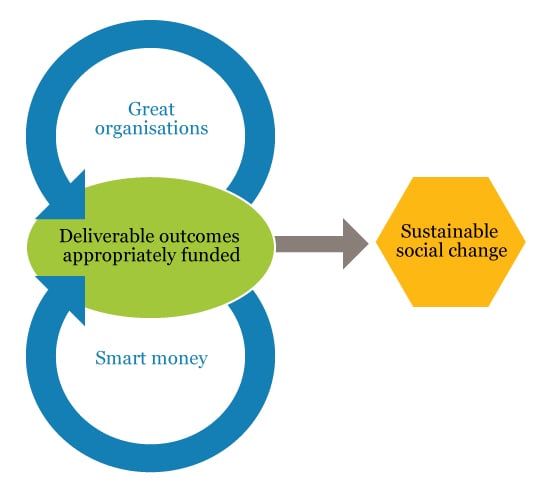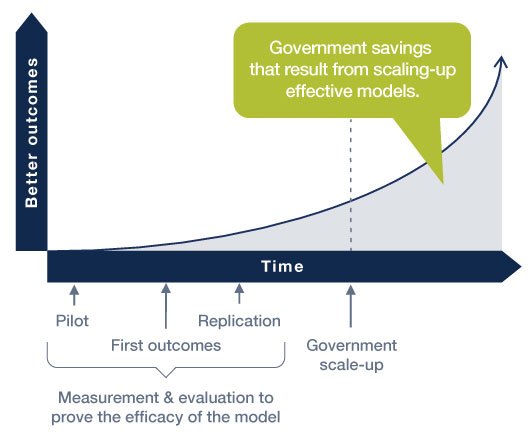Why and how corporate funders should manage to outcomes
Five reasons why corporate philanthropists need to adopt an outcomes management approach, the priorities to consider and how Woodside has done it.
In recent years, we have seen an evolution in corporate philanthropy with many funders adopting a more strategic, long term approach often focussing on a single systemic issue to achieve greater impact. Many funders are also recognising the importance of measuring social outcomes to drive decision-making and to ensure that for every dollar invested, there’s more impact created than the last dollar. As a result of this shift, we are seeing greater application of business practices and principles to social investment activities and an increase in transparency and accountability. Some companies have started to invest strategically based on an evidence base of what works and a clear ‘theory of change’, measuring and evaluating outcomes and continuously refining their approach.
A recent London Benchmarking Group (LBG) review of corporate investment[1] highlighted that impact measurement is important to 97% of companies surveyed, and 65% have plans to measure their impact in the coming year.
… now corporate leaders are looking for hard evidence of the value being generated through community investments.
So why is it so important for corporate funders to measure and evaluate their social investment activities? What are the key considerations when designing and embedding effective approaches to measurement and evaluation?
In the past couple of years SVA Consulting has supported a number of corporate funders to manage to outcomes[2]; here we share our learnings from these engagements and specifically elaborate on insights from our work with Woodside, Australia’s largest independent oil and gas company.
Why is it important for corporate funders to measure impact?
Just as shareholders demand that companies are transparent about their finances and core business activities, corporate funders are increasingly expected to be accountable for their community investments. There are a number reasons why measuring impact is important for funders[3].
Reason #1: Maximising impact
Corporate funders want to know that they are having a positive social impact and maximising the effectiveness of funding for the communities they aim to support.

It takes more than just great social purpose delivery organisations to create sustainable social change. Funders need to have a clear purpose, understand the context in which they operate, set clear goals, make investments to deliver on those goals, and crucially, measure and evaluate performance against those goals. Private sector organisations do this for their core business activities and should accept no less for their social investments.
Not measuring and understanding the impact and effectiveness of investments may lead to missed opportunities for growth and innovation. Through evaluating investments, funders can shine a spotlight on what works. Of equal importance, evaluation can help to identify investments that don’t work and revise those programs or reallocate resources.
Reason #2: Proving models to be taken to scale
Another philanthropic trend is a greater focus on systemic issues and the emergence of philanthropists who aim to test and prove the efficacy of models so that effective investments can be replicated and scaled. These philanthropists play an important role in reforming the broader social policy framework and achieving better outcomes at scale – a role that is underpinned by effective measurement and evaluation (see Figure 2).

Reason #3: Accountability
In austere times, it is particularly important for corporates to be able to demonstrate ‘value for money’ to stakeholders and shareholders. This includes being able to demonstrate both the social impact and the value to the business including brand and reputational benefits, positive impacts to the bottom line (for example in the case of Shared Value investments), employee commitment and community engagement (which is particularly important for extractive companies that require a social license to operate).
In the past, stories of social change may have been sufficient, but now corporate leaders are looking for hard evidence of the value being generated through community investments.
Reason #4: Clarity and communication of purpose
In the process of designing and embedding approaches to managing to outcomes, funders gain greater clarity about what they are trying to achieve. This clarity can be useful for engaging key internal and external stakeholders, making robust decisions about future investments and perhaps even attracting co-funders to leverage impact. With many funders wanting to focus on addressing single systemic social issues, the ability to attract support from a range of different stakeholders (government, philanthropy, private sector and non -profits) is imperative.
Reason #5: Capacity building investees
Finally, corporate funders can also use their managing to outcomes approaches to develop similar capacity within the partners they fund thus enhancing the ability of those organisations or programs to increase their own impact.
To realise meaningful benefits, corporate social investment cannot be seen as another ‘box ticking activity’ but in fact must be executed as professionally, strategically and proactively as core business activities.
What are the key considerations for corporate funders measuring social outcomes?
Whilst most corporate funders understand the importance of measuring their impact, how to do this remains a great challenge for many social investment professionals. Social benefits are often long-term or intangible which can make measurement seem too difficult.
Through our work with Woodside and other corporate funders, we have consolidated four key considerations to help organisations manage to outcomes.
- Be clear on the outcomes you seek and therefore on what you should measure
- Test your approach with grantees
- Embed outcomes thinking into your ongoing portfolio management
- Be realistic about the timing of outcomes realisation and aggregation
Here we outline these considerations and how Woodside applied them.
The Woodside Development Fund: an example of engaged and strategic corporate investment
Frustrated with the status quo of funding multiple individual organisations and projects across a range of issue areas, in 2014 Woodside decided to do things differently. They chose to allocate a proportion of their social investment budget towards a single systemic issue and launched the Woodside Development Fund (WDF) to focus on early childhood development.
“[We] want to leverage further funding… by proving the impact of innovative programs so that they can be replicated at scale.”
This initiative funds the ‘glue’ in communities that can build capacity, drive better coordination and therefore improve access, uptake and quality of services available for families with young children ages 0 to 8. Through a co-design process with the early childhood development sector, Woodside decided on the bold goal ‘Zero to Eight. Life’s Great! every child thrives in their development, learning and life’.
Since the launch, the Fund has invested in a range of place-based collaboration projects as well as programs to build capacity within the sector and enhance leadership and advocacy to drive systems change.
“We are taking a strong outcomes focused approach and want to drive continuous improvement and leverage further funding into the early childhood sector by proving the impact of innovative programs so that they can be replicated at scale,” says Jo Ferrie, Manager Social Investment, Woodside.
From June 2015 SVA Consulting supported Woodside to develop and embed an approach to managing to outcomes for the Fund.
In developing and embedding its approach, Woodside applied the four considerations.
Consideration #1: Be clear on the outcomes you seek and therefore on what you should measure
Alignment about what the organisation is doing and why might seem obvious, but this is not always clear in practice or widely understood across stakeholders. As such, this is a crucial first step in designing any managing to outcomes approach. SVA uses program logic models to answer the following key questions:
- What is the social issue that you are addressing?
- Who are the key stakeholders that you are trying to benefit?
- What activities will you fund to address the issue for those beneficiaries?
- What will be the consequences (outputs and outcomes) of those activities?
- What is the ultimate impact that you aim to achieve?
In Woodside’s case, they used a co-design process managed in collaboration with the Centre for Social Impact to engage widely with the early childhood sector to understand the issues, seek input on the types of activities they should fund and determine the impact they aimed to achieve.
It was agreed that the Woodside Development Fund would address persistent and entrenched vulnerability in challenged communities and the major gaps in the system for supporting early childhood development in those communities. To achieve this Woodside is investing in place-based collaborative interventions in selected communities and programs that will build core capability in the system. They also aim to ensure that learnings from these programs are shared to enhance leadership and advocacy at a state and national level to ultimately drive systems change.
To achieve the Woodside Development Fund’s intended impact of a significant improvement in outcomes for children in communities of interest, various outcomes need to be realised along the way. They include:
- Social outcomes – for example improved health and learning for children and increased capability of parents and carers to support their children’s learning
- System outcomes – at three levels:
- Grantee/program level – enhanced capacity and capability
- Community level – improved collaboration and responsiveness to community needs
- State/national level – improved evidence of what works and supportive policies.
Corporate funders in general also need to recognise and measure other benefits to satisfy all stakeholders. In the case of Woodside, we included an additional two pillars in the framework:
- Business impacts – for example employee engagement, brand and reputation and key stakeholder perceptions[4]
- Fund management – how well the fund is being managed to enable achievement of the outcomes including progress versus key milestones, budget management and leverage (financial and non-financial).
Further detail on how funders should think about defining their philosophy, purpose and strategy can be found in the article: Find your philanthropic true north.
Consideration #2: Test your approach with grantees
Another consideration is the importance of collaborating with grantees and testing your framework for managing to outcomes along the way.
Woodside engaged all existing grantees whilst designing their framework to ensure that the requirements were realistic in terms of data collection. They also wanted to ensure that the framework would accurately evidence the impact that grantees aspire to achieve and would be useful for grantees as well as Woodside as they collectively strive to improve programs.
Funders should be sure that reporting expectations are appropriate for the duration and quantum of the investments and where grantees are being supported by multiple funders, there should be alignment where possible so as to not overburden grantees.
For Woodside, this early engagement has meant that grantees have been challenged to measure outcomes, but are not overburdened with reporting requirements. Ferrie reflected “the process has helped us to establish trusting relationships which has led to open and honest evaluation meetings that focus on how Woodside can support the grantee to overcome challenges, build capacity and drive towards the outcomes they aspire to achieve together.”
Consideration #3: Embed outcomes thinking into your ongoing portfolio management
Making sure that outcomes measurement is embedded into the management of the portfolio ensures that timely data is collected and that derived insights can be used to improve portfolio management on an ongoing basis.
One useful method for simplifying the process of managing to outcomes for both grantees and funders is to provide grantees with standardised data collection templates that outline the type and format of data and information to be collected. Templates for a portfolio of grantees can then be collated in a central tool managed by the funder to produce useful dashboards or reports for the social investment team, corporate management and the public.
These reports should inform periodic meetings between you and the grantees, and with internal management focussing on what has been learnt and what can be improved moving forwards (either within the bounds of funded projects or when considering new investments).
… it might take years to see improved student achievement, so outputs and short term outcomes should be measured to gain earlier insights into program effectiveness.
Consideration #4: Be realistic about the timing of outcomes realisation and aggregation
Social outcomes ensue at a different pace to business outcomes. While commercial managers might expect revenue or cost reduction outcomes to show within months, real social outcomes such as reducing disadvantage may take many years to come to fruition.
For this reason, we recommend measuring outputs and intermediate outcomes that allow early insights into the long term impact so that the strategy can be refined along the way. For example, it might take years to see improved student achievement, so outputs, such as attendance and short term outcomes such as teacher reported engagement should be measured to gain earlier insights into program effectiveness.
Finally, companies have a strong desire to aggregate social data in the same way they aggregate and report on financial data. However, social data will come in very different forms, depending on the context and population affected, so it therefore may not make sense to aggregate social data. This means that companies should be careful how they report on and compare different investments across their portfolio.
Conclusion
The majority of corporate funders are not measuring the outcomes of their philanthropic programs in a comprehensive way, but we expect this to change rapidly as more pressure is put on companies to demonstrate their impact.
Managing to outcomes is as critical for funders as it is for service delivery organisations. Both groups need to collect data and use it to continuously improve funding and delivery decisions to achieve sustainable social change. For progressive corporate funders who want to focus on complex systemic issues through collaboration, capacity building and proving models for scaling, developing an evidence base of what works is even more imperative.
Although measuring the impact of investments can be challenging and is not an exact science, frameworks such as Woodside’s make ongoing management to outcomes achievable and useful for both funders and grantees. Woodside’s framework has focussed the Woodside Development Fund and all its stakeholders on the long term impact that they aspire to achieve together, and will ensure that all fund decisions stay true to the bold goal.
The approach to managing to outcomes cannot be an off-the-shelf product. However, the methodology SVA has applied and the lessons learned with various clients is a useful platform for corporate funders to effectively measure and evaluate impact.
Endnotes
[1]10th London Benchmarking Group (LBG) Annual Review of Community Investment (Australia & New Zealand, 2015)
[2] ‘Managing to outcomes’ is a continuous process of using outcomes data to inform better decision-making and improve project design and delivery
[3] Note: all 5 reasons are relevant to all types of funders including corporate funders, philanthropic funders and Government.
[4]For the Woodside Development Fund ‘Shared Value’ is not a core focus where as for other corporates the business impacts will be those that impact the company’s bottom line.
More information
For further information on SVA’s consulting services for funders, contact consulting@socialventures.com.au
If you would like to find out more about the Woodside Development Fund or join forces with Woodside to support the achievement of their bold goal – ‘Zero to Eight. Life’s Great! every child thrives in their development, learning and life’ please contact Jo Ferrie, Woodside’s Social Investment Manager at communities@woodside.com.au.

